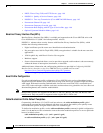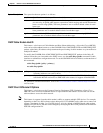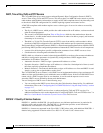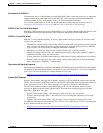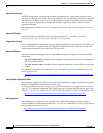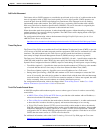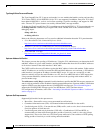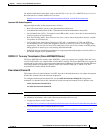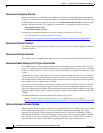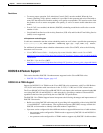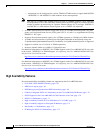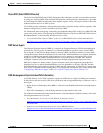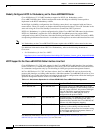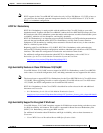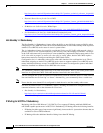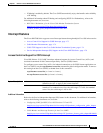
1-66
Cisco uBR7200 Series Universal Broadband Router Software Configuration Guide
OL-2239-05
Chapter1 Overview of Cisco uBR7200 Series Software
Supported Software Features for the Cisco uBR7200 Series
Downstream Frequency Override
Downstream frequency override allows the CMTS administrator to change the downstream frequency
assigned to a cable modem, overriding the frequency set in the cable modem DOCSIS configuration file.
To enable cable downstream frequency override, use the cable downstream override command in cable
interface configuration mode. To disable the override feature, use the no form of this command.
cable downstream override
no cable downstream override
For additional command information, refer to the following document on Cisco.com:
• Cisco Broadband Cable Command Reference Guide
http://www.cisco.com/univercd/cc/td/doc/product/cable/bbccmref/bbcmtscf.htm#wp1080840
Downstream Packet Classifier
This feature helps to map packets into DOCSIS service flows. The Cisco CMTS supports downstream
IP packet classifiers.
Downstream Packet Scheduler
This module controls all output packet queuing service on the downstream link of each cable interface.
Downstream Rate Shaping with IP Type of Service Bits
Cisco uBR7200 series routers support downstream data rate shaping on a per-modem basis. The Type
of Service (ToS) bits in the IP packet header can be set to specify that packet's class of service, allowing
packets for certain traffic flows (such as VoIP) to be given precedence over packets for other flows (such
as data).
Downstream rate shaping with ToS bits allows you to configure multiple data rates for a given modem.
Also, by specifying a maximum data rate for a particular ToS, you can override the common maximum
downstream data rate. Packets that contain ToS bytes that have not been configured for downstream data
rates continue to use the common data rate limits.
Prior releases set the ToS bits to zero; however, with the advent of virtual private network (VPN) and
QoS applications, it is desirable to copy the ToS bits when the router encapsulates the packets using
generic routing encapsulation (GRE). Thus, intermediate routers between tunnel endpoints can also take
advantage of QoS features such as weighted fair queuing (WFQ) and weighted random early detection
(WRED).
For additional information, refer to the following document on Cisco.com:
• Downstream Rate Shaping with TOS Bits for the Cisco uBR7200 Series Cable Router
http://www.cisco.com/univercd/cc/td/doc/product/software/ios120/120newft/120t/120t5/tosbit.htm
Optional Upstream Scheduler Modes
With this feature, the user is able to select either Unsolicited Grant Services (UGS) or Real Time Polling
Service (rtPS) scheduling types, as well as packet-based or TDM-based scheduling. Low latency
queueing (LLQ) emulates a packet-mode-like operation over the Time Division Multiplex (TDM)
infrastructure of DOCSIS. As such, the feature provides the typical trade-off between packets and TDM:
with LLQ, the user has more flexibility in defining service parameters for UGS or rtPS, but with no
guarantee (other than statistical distribution) regarding parameters such as delay and jitter.



